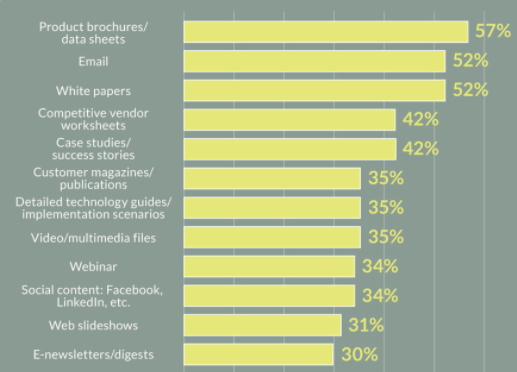
Image source: Instant Magazine
If you read the latest best practices around content marketing, you might be confused about how exactly to connect with prospects through content.
On one side, you hear repeatedly that the human attention span has shrunk to less than that of a goldfish — a mere 9 seconds. And on the other side, SEOs now say the best way to rank on search engines is with lengthy content — length being a signal that what you’ve delivered is “in-depth” and therefore more authoritative.
So, which is true? Do your prospects want 9-second sound bites or deep dives? The truth, although unsatisfying, is “it depends.”
At pivotal moments in the buyer’s journey, your prospects will need different types of content to nudge them further down your funnel toward making a purchase.
When those potential buyers have identified their problem and are now shopping around for the best solution, they’re more likely to appreciate the deep dive — authoritative, educational, non-promotional content that helps them figure out what to do next.
There is no better content asset than the white paper to meet that need.
How white papers can fill your funnel
According to the DemandGen Report – 2017 Content Preferences Survey, white papers remain one of the most valued content assets for your buyers. More than three-fourths of survey respondents said they are willing to exchange information about themselves for white papers.
Nearly every form of content other than webinars scored lower, including e-books, case studies, analyst reports, podcasts and infographics.
But not only does offering a high-quality white paper affect your lead generation — it can directly influence your sales. More than half the respondents to the Eccolo Media B2B Technology Content Survey, for example, reported reading a white paper before they made a buying decision.

Image source: Eccolo Media
This means that if you can create in-depth, engaging content that readers are eager to spend 5, 10, 15 or 20 minutes with — and that helps them make a better buying decision — it could affect your budget, status and performance reviews at work.
However, the continued value of white papers for marketing and lead generation hinges on awareness of how people consume information today.
Your buyers are more likely than ever to read on their mobile devices. They are more likely to retain information that is visually appealing and accommodates skimming. And they are more likely to engage with your white paper if you give them multiple options for accessing it — the traditional gating form is not the only way to go.
Interactive white papers deliver ROI
With so much on the line, you cannot afford to cut corners with poorly designed, text-heavy PDF white papers. Not only are PDFs non-responsive and static; but once downloaded, they’re freely sharable, they can’t be measured and you get little insight into how readers interact with them.
Interactive, digital white papers don’t have these limitations. Here are 4 tips on using interactive white papers to help you capture and maximize the return on your investment:
1. Personalization goes a long way
Whether your readers fill out a form or give you access to their social profiles to unlock a gated white paper, the information they share should earn them a more personalized experience.
For instance, you can address your reader by name at key points throughout the text. Personalizing content to your readers and their interests is more engaging and can increase the time spent reading your content by 22 percent.
2. Multimedia improves the prospect’s experience
You no longer need a team of designers and developers to create beautiful content assets. Non-designers can create immersive digital publications themselves.
When you do so, draw on professionally created multimedia to make them special and easy to digest. The human brain processes images 60,000 times faster than text. Embed relevant photography, video and other creative content into your white papers to attract and retain readers’ attention.
3. Great white papers spark social sharing.
Amplify the connection you make with your prospects by delivering an exceptional white paper experience and then making it easy for them to share. With digital white papers, readers can share the whole asset or (if you enable the option) can share individual pages via LinkedIn, Twitter and other social media channels.
4. Benchmark and optimize your white paper.
Digital publications allow you to analyze engagement and reader behavior, but that’s only useful if you set measurable goals.
For example, decide how many new readers do you want to attract to your content, how long you want them to spend on each page and how many you expect to read 100 percent of your white paper.
Then, measure performance using Google Analytics and update your content based on the insights you’ve gathered. Unlike with a static PDF, you can continue optimizing your published content over time to better engage readers and boost ROI.
Conclusion
Reports about our goldfish-like attention spans may be somewhat exaggerated. Certainly, buyers are willing to pay attention when they have in-depth, engaging content that is worthy of their time.



